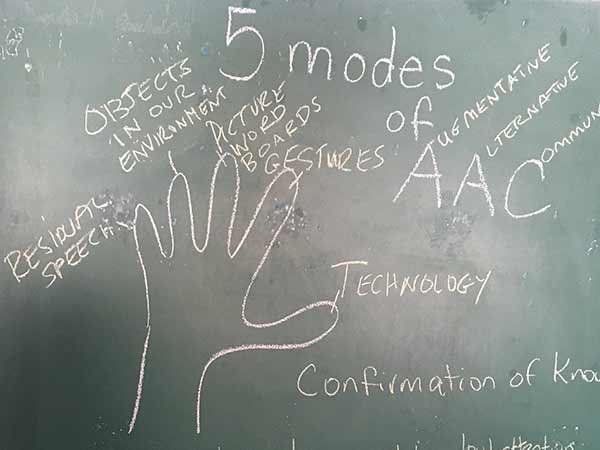Fayth Says

Building Augmentative Alternative Communication (AAC) capacity within a school district is one of the many custom requests that can be made at SET-BC. At Rocky Mountain School in Elkford B.C., School Districts 5 and 6 came together for a three year project designed to build understanding of AAC.
The team was able to coordinate around Fayth – an amazing and energetic student who was transferring in from preschool. Fayth has been diagnosed with Angelman’s Syndrome secondary to Autism Spectrum Disorder, and is nonverbal. The team wondered how to help her grow into a thriving, integrated, highly communicative member of her Kindergarten room, and requested that the SET consultant focus on developing a plan around classroom integration of Augmentative Alternative Communication (AAC).
The goal for the first year of PL services was to learn the basics of AAC such as ‘5 modes of AAC’, and included a two day Professional Learning series entitled “Beginning AAC”. The second year included ‘SLP shadowing’ which saw the SET BC consultant on-site at the beginning and end of the year to work with the team. The focus was around methods to increase communication and create strong inclusion practices such as using peers as models for communication, and teaching using multiple forms of nonverbal communication (pictures, gestures, vocalizations, objects in the environment and technology). Together, a knowledgeable and skilled AAC team was created to collaborate and focus on Fayth’s cognitive and communication learning. Team membership included the learning support team, multiple SLPs, classroom teacher, EA’s, Vice Principal, and parent.
During the end of the second year the AAC team chose a vocabulary method for Fayth – Pragmatic Organization Dynamic Display (PODD). Resources and training opportunities were created to ensure successful team implementation. The dedication and strength of the entire team was outstanding; with administration support, the team arranged weekly prep time for AAC. Full team meetings were scheduled and completed every 6 weeks to review and adapt curriculum, choose vocabulary, build and wear the communication book, train every student to be a communication partner, to measure both the understanding and ability to use the vocabulary, and to create applied behaviour analysis focused on teaching concepts in thematic units.
As we are ending our third year together, Fayth’s achievements show significant growth. She has vocabulary to control her environment, develop peer relationships, comment and complain, request and refuse, and express her understanding of cognitive processes within the classroom curriculum. The most rewarding part, having been part of this team for so long, is seeing Fayth’s peers and educators respond to her communication through verbal sounds, gestures, pictures, objects and other technology.



